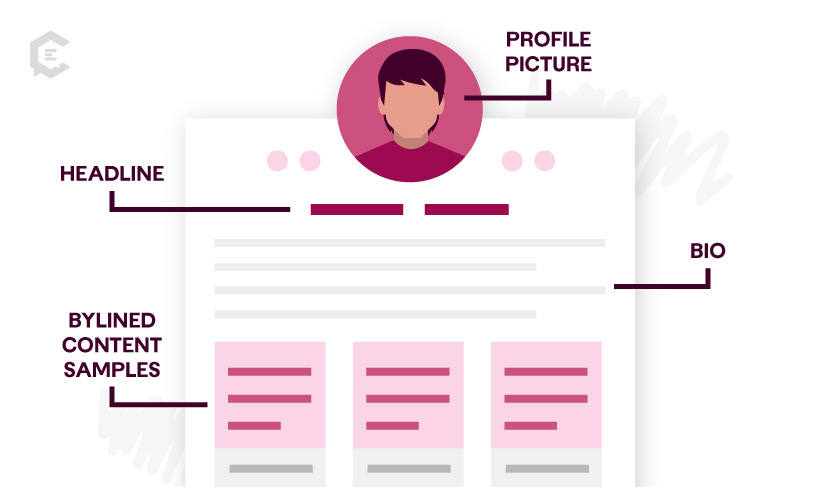The freelance world is full of opportunities right now. And a well-crafted freelance writing portfolio is the defining factor that sets you apart.
This comprehensive guide arms you with the knowledge and tips to build a compelling portfolio that captures attention and helps you win contracts. We’ll also cover common mistakes, how to showcase your portfolio effectively, and the best ways to keep your portfolio up to date.
Understanding the Freelance Writing Portfolio
Simply put, your freelance writing portfolio is a curated collection of your writing pieces. More importantly, it’s your calling card and first impression. Through it, you’ll showcase yourself and your expertise to prospective clients.
Freelance writing is an umbrella term for a multitude of content types, including:
- Copywriting
- Blogging
- Whitepapers and eBooks
- Ghost Writing
- Social Media Copy
- Technical Writing

The type of work you’re targeting, or your “niche,” will determine how you build and tailor your portfolio. That tailoring should reflect your expertise and capability in your chosen area. And with 71% of employees in the U.S. planning to freelance in 2023, it’s beyond essential to craft an impressive portfolio to stand out from the competition.
By aligning your portfolio with your career goals, you’ll attract the right opportunities and position your freelance writing career for success.
Crafting an Impressive Freelance Writing Portfolio
Building a compelling freelance writing portfolio is an art form. Each element must strategically showcase your capabilities and intrigue potential clients. But before you start impressing, there are a few fundamentals to cover. They will lay the groundwork and set up your portfolio for success.

The Essentials
For any quality freelance writing portfolio, you need a solid baseline. That consists of the following critical elements:
- Profile picture: Humans are visual creatures. 90% of information transmitted to the brain is visual. A high-quality professional profile picture helps put a unique face to your name, showcase your personality, and create a personal connection.
- Headline: The first text someone reads. A great headline succinctly summarizes who you are as a writer, your expertise, and your unique value proposition (UVP).
- Bio: Here’s where you dive deeper and outline your skillset, experience, writing style, and a little of your personality. It helps show potential clients why you’re the right choice for them.
- Bylined content samples This is where the work speaks for you. Bylined samples are articles or pieces you’ve written that carry your name as the author. These are extremely important because they provide tangible proof of your writing experience. Aim for at least three published pieces showcasing your skill and writing style.
FAQ: What if you’re just starting?
If you’re just starting and don’t have any published work yet, use the headline and bio to stand out as much as possible. It would be even better to use the education section to show qualifications that match the fields you’re trying to work in. For writing samples, if you have to, you can attach PDFs or publish your writing on Medium and then link it back to the portfolio.
The essentials lay the foundation. But your portfolio doesn’t stop there. Once those are in place, you can sculpt your portfolio to truly stand out.
Organizing and Structuring Your Portfolio
Once you’ve assembled the essentials, it’s time to focus on structure and presentation. These are critical in creating an engaging, user-friendly portfolio that captivates readers and smoothly guides them through your professional story.
Visual Presentation
It’s crucial to position your most impactful content at the top of your CV. That means writing samples that best represent your skills, style, and the type of work you’re targeting. The more specific, the better. They should be intuitively organized and easily accessible. Some of the top categories of samples to include are:
- Published articles and blog posts
- Guest posts or contributions to other platforms
- Writing samples from client projects or personally published work
How to Stand Out
Your portfolio is your platform to stand out and show your uniqueness. It’s your tool to attract ideal clients. Emphasizing your niche experience is one of the most effective ways to do this. If you specialize in technical copywriting, put your best tech-focused pieces at the top of your portfolio. If your strengths are more in the persuasive blogging category, highlight those samples instead. Although displaying your overall capability as a writer is important, specialized experience is the most valuable way to stand out.
Education is a great way to emphasize your authority. Attaching relevant degrees, certifications, and courses can be a fantastic way to do that. It’s also a great tool for Talent Managers to use when pitching you to potential clients.
Finally, don’t underestimate the power of a well-crafted description for each sample. Succinctly summarize the context and purpose of each piece, as well as your role and achievement in it. The descriptions provide valuable insight into your process and skills and tell the reader why each piece matters.
A well-structured and visually compelling portfolio creates a dynamic representation of your writing career. The best ones show potential clients exactly why you’re the writer they’ve been searching for. Here are two fantastic examples on the ClearVoice platform you can use as a guide:

Common Mistakes When Building a Portfolio
Even the best portfolio can have a slip or two. Being aware of common mistakes saves you time and effort. It also ensures your portfolio reflects the best of your capabilities and gives you stronger opportunities to secure work. Here are some of the most common pitfalls to avoid:
Including PDFs and Putting Them First
It might seem practical to include PDFs. But it’s important to remember your best-bylined work should lead your portfolio. Bylined work affirms your credibility and authority, while PDFs don’t. So don’t bury your bylined work under a mountain of PDFs. And only use PDFs if you have to.
Writing Your Bio Like a Cover Letter
Your bio should tell your story, but it’s not a sales pitch or cover letter. Avoid using overly formal language or cramming in too much information. The best way to “sell yourself” is to provide an engaging, concise overview of who you are and your expertise. Consider it an invitation to potential clients to get to know you better. And when you work with companies like ClearVoice, that strategy sets the Talent Managers up for success. They can do the selling for you.
Using AI
Although AI tools are convenient, they can’t replicate your unique personality and voice. Don’t use AI to craft a portfolio that you think will get you hired. Instead, invest your time and energy into showcasing your uniqueness. Your portfolio should be a reflection of your writing journey and style. That’s not something AI can mimic.
Grammar Mistakes
While this might seem obvious, watch out for grammar mistakes slipping through. It’s especially important if you’re a writer. If you have errors in your portfolio, people will think those mistakes will continue into the work you’d do for them. Utilize tools like Grammarly to help catch and correct errors quickly. But, always remember to also review your content manually. That ensures a clean, error-free portfolio that signals to clients you’re committed to quality.
Showcasing Your Portfolio Effectively
Alright, you’ve crafted an impressive freelance writing portfolio that’s mistake-free. Now, it’s time to get it out there into the world. Here are the best ways to showcase your portfolio effectively.
Build a Professional Digital Presence
In today’s world, your online presence often serves as your first impression. Building a professional website or using a quality portfolio platform to host your work is crucial as a freelancer.
Designing a visually cohesive and appealing website sets the tone for your image. It’s how you communicate your professionalism, brand, and style. And showcasing your professionalism extends beyond the visuals.
Remember to prioritize usability. Use an intuitive design with easy navigation to enhance your audience’s experience. And don’t forget about SEO. Optimizing for search engines makes it easier for potential clients to find you. Create engaging and relevant content, use keywords effectively, and keep your site active if you can.

Harnessing the Power of Social Media
Platforms like LinkedIn have become essential tools for freelancers. They’re opportunities to connect with potential clients and engage with fellow freelancers. A strong LinkedIn profile that aligns with your portfolio creates a cohesive professional image. It also confirms who you are and what you’ve written. Not to mention, eight people get hired every minute on LinkedIn.
And you don’t have to limit yourself to LinkedIn. Depending on your niche, other platforms like Twitter, Instagram, and Medium can be places to showcase your expertise and share your latest work. That can lead to an engagement with your audience that generates more work opportunities.
Leveraging Metrics and Client Testimonials
A client referral, review, or testimonial is more persuasive than any self-promotion. Whenever you can, ask satisfied clients for recommendations or testimonials. It enhances your credibility by adding social proof to your portfolio.
And if your work has generated impressive metrics, showcase them. Metrics add tangible evidence of the value your work can deliver. Include things like:
- High engagement rates
- Social shares and likes
- Boosting sales
But make sure these additions align with your overall portfolio. They should enhance and support your expertise, not distract from it. Just like the rest of your portfolio, focus on quality over quantity.
Growing and Evolving Your Freelance Writing Portfolio
Building a standout portfolio isn’t a one-time thing. It’s an ongoing process that requires regular updates, expansion, and continual learning. Here are three ways to ensure your portfolio keeps pace with your evolving career.

Updating Your Portfolio
It’s a common misconception that portfolios should always feature your most recent work. High-quality, relevant content beats timelines. Your portfolio should exhibit the best of your capabilities. If a piece of writing demonstrates that but is a couple of years old, it still deserves a spot.
But that doesn’t mean letting your portfolio become static. Regularly revisit and revise your portfolio. And update it with new pieces that illustrate you developing skills and experiences.
Diversifying and Expanding Your Niche
Your portfolio is a reflection of you. Even if you have a specialized niche, showcasing your versatility can make you more attractive to a wider range of clientele.
Consider taking on challenging projects outside your comfort zone. They’ll broaden your expertise and give you new samples to add to your portfolio. And actively seek opportunities for ongoing improvement and growth. Watch for education and certification courses to boost your authority and stay up-to-date.
Refinement Through Feedback
Your portfolio should match your evolution as a writer. One of the best ways to ensure positive growth is through feedback. Talk to your fellow writers. Seek out mentors. You can even ask clients for constructive criticism. All those avenues provide fresh perspectives. Those perspectives help identify any blind spots you or your portfolio have. They also give valuable insights for improvement.
As a freelancer, your journey never ends. Receiving feedback opens the door to your continual growth and development.
Are You Ready to Build Your Portfolio?
Building an impressive portfolio is essential whether you’re new to the game or an established writer. And there’s no better time to take that step. Compile your best work, curate your content, and craft your narrative. Then present it to the world and let it see the extraordinary freelancer writer that you are. And if you need any help, feel free to talk to us today. We’re happy to get you started.



